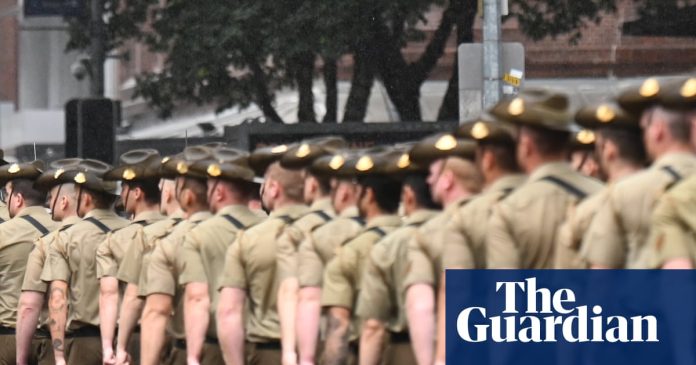The Australian defence force has failed to meet its latest recruitment targets despite recording the highest recruitment and retention levels in more than a decade, driven in part by ads on TikTok and in video games.
The ADF enlisted 7,059 full-time personnel in the 2024-25 financial year, the highest annual intake in 15 years, but still fell more than 1,000 short of its target for that year.
According to the Department of Defence’s incoming government brief, released under freedom of information laws, the recruitment target for the last financial year was 8,105.
The figures also show fewer than 10% of applicants to the ADF in the last financial year were hired, with some dropping out due to the drawn-out recruitment process and many not meeting its strict standards.
Sign up: AU Breaking News email
More than 75,000 people applied to join, while just 7,059 permanent roles were filled.
The government has acknowledged some applicants had dropped out or found other work, and that its commercial contract with the recruitment company Adecco has had “teething issues”.
“As we’ve been trying to streamline that recruitment process, there were some teething problems with our new recruitment partner,” said the minister for defence personnel, Matt Keogh.
“I have lent in very hard … to get them back on track with applicant care as well as making sure that in doing the assessment of medical and psych appointments that they are able to be accessed more promptly.
“This has now seen great improvement, we’re a long way there, we’ve still got a little bit more to go.”
As of 1 July, the full-time ADF workforce was at 61,189 people.
The latest data, provided by the defence department, shows retention has also improved, with separation rates dropping to 7.9%, after sitting between 9% and 11% since 2012.
The defence force has a target of 69,000 personnel by the early 2030s, to respond to rising geopolitical tensions.
At Senate estimates in June 2024, the chief of defence told the hearing that on 1 May that year the ADF workforce was 4,400 personnel short, with the total workforce at 58,284 people.
Despite the shortfall in reaching the recruitment goal for the last financial year, the government said recruitment was now on track to meet the 69,000 target.
The government said some of that improvement had come from targeted social media campaigns for Australians aged between 17 and 24 in what Keogh called “smarter” advertising.
“Doing that advertising in games, in computer games, utilising TikTok, making sure that we’re focusing on having that advertising presented where our target age groups are so they are seeing those messages,” Keogh said.
after newsletter promotion
“Advertising [is also] targeted at those key influencers of our potential enlistees, our young people – so people like parents and teachers.”
The ADF is also recruiting from overseas, though its program to recruit from Five Eyes partners has started slowly.
So far just three New Zealanders have joined the ADF, with a further 70 in the pre-enlistment stage, meaning they could be undergoing fitness tests or waiting for security clearances.
Applications opened up to the other Five Eyes nations – the US, the UK and Canada – on 1 January, and more than 500 people across the four countries have applied.
The ADF recruited 185 personnel from overseas militaries through its lateral recruitment program in the last financial year. That program is for members of a foreign military who can address critical ADF skill shortages.
Keogh also said the government’s work to deliver the recommendations of the royal commission into defence and veterans’ suicides was a factor in trying to attract people to the ADF.
“Delivering on the recommendations of the royal commission … is really important for improving people’s perceptions of, and therefore also their willingness to join the Australian defence force,” he said.
“We’re … conscious that we have more work to do in this area as well.”
The royal commission handed down its report to the government in September, with 122 recommendations, including the establishment of a body to help defence personnel transition to civilian life and access support.
The government agreed in principle to 104 recommendations and has established a taskforce to implement them.
